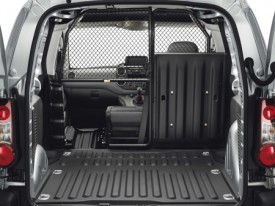
Partner Electric: stylish, practical and best of all, cheap to run
Peugeot Partner Electric
What is it?
Peugeot’s 100% electric-powered version of its highly capable Partner van is aimed at urban business users wanting to cut fuel bill costs and reduce their environmental impact.
Depending on the price of a kilowatt hour at the charge point, the Partner Electric will cost between 76 pence and £1.70 to do 60 miles. Think about that – it’s as little as 80 pence to cover the Peugeot Electric’s 105 range. Any business comparing that with a conventional van would have to take notice.
In common with its conventionally powered stablemate, It comes in two length versions – L1 at 4.38m and L2 at 4.63m, giving it the largest load volume of small electric vans on the market.
The Peugeot Electric’s range is up to 105 miles – and 70% of small van buyers drive less than 60 miles a day
Clearly, only businesses operating vans in urban environments and covering limited mileages will be likely customers. But the Peugeot Electric has a potential range of 105 miles, making it viable for many types of operation.
Indeed, 70% of small van buyers’ usage amounts to less than 60 miles a day.
This impressive range – the best in the sector – is achieved using ‘dual-energy recovery’, with conventional recovery on deceleration capturing energy when releasing the accelerator pedal or during braking, combined with on-board electrical capacity of 22.5kW hours, improved aerodynamics, under-body aero devices, and a top speed limited to 68mph.
But driving style will affect energy consumption, as will the main energy-consuming systems – heating and aircon.

Partner Electric’s load capacity is best in class
To help with this, the Partner Electric uses a fully electric system to blow hot or cold air directly into the cab so it’s quicker than a conventional system.
Switching to an ECO mode instantly switches off the heating or aircon while maintaining ventilation, giving an immediate boost in range.
What’s it like to drive?
The Partner Electric is a joy to drive. The cab mirrors that of its diesel-powered stablemate with comfortable seats, offering good support, and seat adjustment that allows a good driving position to be attained easily.
The controls are familiar – ‘ignition’ key, handbrake, four-position gear selector (park, reverse, neutral and drive) and brake and accelerator pedals, just like an automatic.
The instruments will be less familiar, though: there’s a power gauge, battery charge level indicator, aircon/heating consumption gauge, and trip computer.

The instruments are unfamiliar: there’s a power gauge, battery charge level indicator, aircon/heating consumption gauge, and trip computer
The electric motor develops 67hp and produces 200Nm of torque, which is available instantly from 0-1500rpm and delivered via a constant single-speed gear reduction unit. The result is swift and super-smooth acceleration, and with no gear changes and no engine noise, it’s certainly a relaxed and peaceful experience.
The two battery packs are under the front and rear of the van, giving a lower centre of gravity than with the standard Partner and providing good dynamic stability, so I’ve no complaints about handling.
And when it comes to safety, the Partner Electric has ABS with Electronic Brakeforce Distribution, and Emergency Braking Assist, as well as Electronic Stability Control. Protection for the batteries also meets rigorous safety standards.
There are two charging modes:
- Fast charging, carried out a special charging station supplied with three-phase 380V, takes 20 minutes to reach 50% capacity and around 35 minutes to achieve 80%
- Normal charging is carried out using 230V mains with connection made via the charging socket behind a flap on the front wing and takes around seven and a half hours to reach 100%.
- Positioned under the vehicle, the battery banks don’t intrude into the load space. The cargo hold dimensions match those of the conventional Partner. L1 versions have a length of 1800mm and 3cu m load volume, and the L2 offers a load length of 2050mm with a best-in-class payload of 695kg.
What’s hot?
- Electric power gives a super-smooth and relaxed driving experience but with plenty of oomph when needed
- Running costs of between 76p and £1.70 per 60 miles depending on electricity price per kWh
- Lower maintenance costs than with conventional vehicles thanks to no oil changes, fewer parts requiring service, and less heavy use of brakes because of energy recovery on deceleration
- Battery and drivetrain warranty over five years or 30,000 miles
- Largest loading volume of all electric vans in the sector
- Zero emissions – there’s no tailpipe!
What’s not?
- Well – the range is only up to 105 miles, but you wouldn’t buy this van if you expected to exceed that.
Business Vans verdict
If an all-electric fits in with your business van requirements, the Partner is a joy to drive, will be easy to live with and offers the same capacity as its conventionally powered stablemates. It’s stylish and practical and, best of all, will be inexpensive to run and eco-friendly into the bargain.
What you need to know
| On the road price as tested (ex-VAT) | £16,750.50 |
| Load length L2 | 2050mm |
| Load width L2 | 1220mm |
| Load height | 1250mm |
| Load capacity L2 | 3.7ch m |
| Payload L2 | 695kg |
| GVW | 2,225kg |
| Towing capacity braked/unbraked | TBA/750kg |
| Engine | Electric |
| Power/Torque | 67hp/200Nm |
| Economy per 60 miles | 76p-£1.70 |
| CO2 emissions | Zero |






Leave A Comment